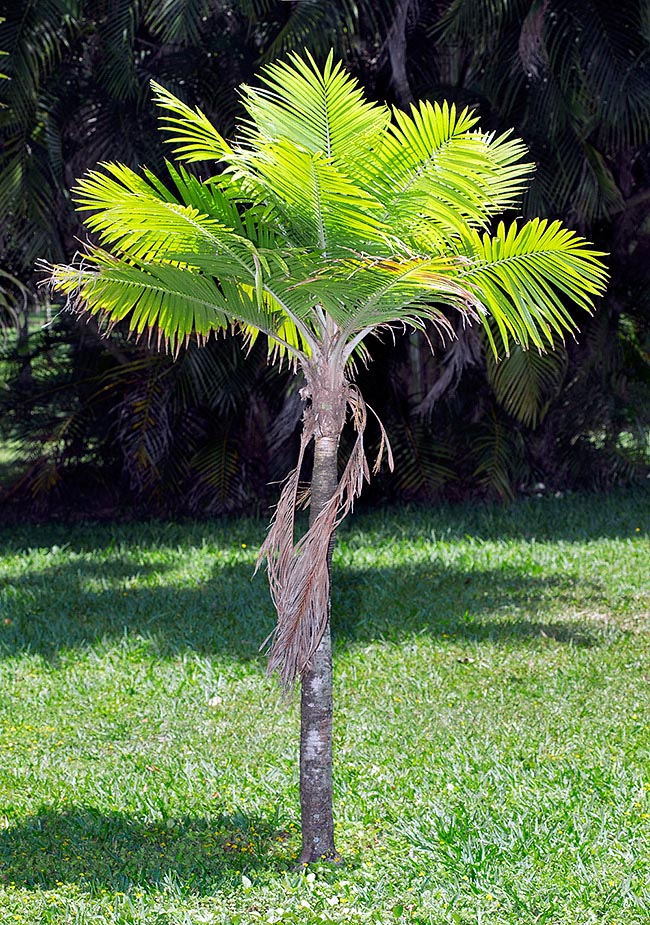Family : Arecaceae

Text © Pietro Puccio

English translation by Mario Beltramini
The species is native to the Comoro Islands where it grows in the humid forests around the 800 m of altitude on alkaline soils.
The genus was dedicated to the German entrepreneur and patron Louis Frederic Jacques Ravené (1823-1879), descendant of a Huguenot family that had taken refuge in Berlin in 1685; the species is honored to the German explorer and botanist Johann Maria Hildebrandt (1847-1881), collector of the type species.
Common names: dwarf majesty palm (English).
The Ravenea hildebrandtii H.Wendl. ex C.D.Bouché (1878) is a dioecious species, solitary, unarmed, with erect stem, of 5-8 cm of diameter, that rarely exceeds the 5-6 m of height, keeping lower in cultivation, of brown grey colour fissured vertically.

Ravenea hildebrandtii of the Comoros, endangered in nature, well adapts, due to its elegant posture and contained dimensions, to the small gardens, tropical and warm temperate, or to decorate, in suitable pots, luminous interiors © Giuseppe Mazza
The leaves, on an about 40 cm long petiole, are pinnate, slightly arcuate, 0,6-1,8 m long, with 20-50 pairs of linear-lanceolate leaflets with acuminate apex, in the median part 30-45 cm long and about 1,5 cm broad, regularly arranged along the rachis in the same plane.
The foliar base, about 15 cm long and open on the opposite side of the petiole, is externally covered by a thick pale brown tomentum.
Inflorescences between the leaves (interfoliar), the male, up to about 50 cm long, with ramifications of first order and solitary flowers intensely odorous, subsessile, with trilobate calyx, 3 petals merged at the base and 6 stamina.
Female inflorescences, up to more than 1 m long, with ramifications of first order and solitary flowers with trilobate calyx, 3 free petals, 6 staminodes, ovoidal gynaeceum and 3 curved stigmas.
Ovoid fruits, about 1 cm long and of 0,8 cm of diameter, of yellow colour when ripe, containing only one globose seed of about 0,5 cm of diameter.
It reproduces by seed, previously kept in water for 3 days, in draining loam rich of organic substance kept humid at the temperature of 26-28 °C, with times of germination starting from 3 months and slow growing.
Particularly elegant, thanks to its limited dimensions can find good location in any type of garden in the tropical, subtropical climate regions and marginally in the warm temperate zones where it can resist exceptional values of temperature up to about -2 °C for very short period.
It requires a semi shady position for getting a more intense coloration of the leaves and fertile soils, draining, slightly acidic to slightly alkaline, maintained humid, even if it can bear short dry periods but with a less luxuriant look.
Young plants can be utilized for long time, seen the slowness of their growth, in pot to decorate luminous inner spaces and for this purpose it met an immediate but short-lived success in Europe by the end of the XIX century.
The species, due to the progressive reduction of its habitat, is inserted into th red list of the IUCN (International Union for the Conservation of Nature) as “Endangered” (at very high risk of extinction in nature).
Synonyms: Ranevea hildebrandtii (H.Wendl. ex C.D.Bouché) L.H.Bailey (1902).
→ For general notions about ARECACEAE please click here.
